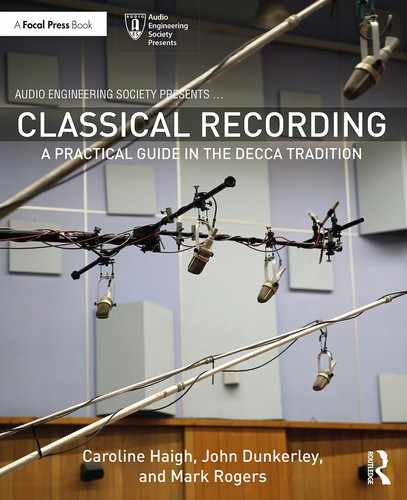Glossary of terms, acronyms, and abbreviations
0 dBFS 0 dB full scale – the highest level on a digital meter, representing full digital modulation.
AB pair A pair of microphones for recording stereo that are spaced apart.
AFL After fade listen – a means of listening to an individual audio signal at the level it is being used in the mix without disturbing the mix bus output. Useful for fault finding while in record.
Cardioid A microphone that picks up sound primarily from its front axis and discriminates against sounds from the rear with reduced output at the sides. The name is from its ‘heart-shaped’ polar response pattern.
Condenser A microphone that uses a variable capacitor as its transducer and requires phantom power or another power supply. They are the most common microphone type used for classical recording (ribbon microphones are the second) because of their smoother and more extended frequency responses and better transient responses when compared with dynamic microphones (which are not normally used for classical recording).
DAW Digital audio workstation – a computer, audio interface, and software programme for recording and editing.
EQ Abbreviation of ‘equalisation’
Fig of 8 Microphone with a figure-of-eight polar response: it picks up sound from sources in front and behind in equal amounts whilst discriminating against sounds arriving from the sides. The electrical output produced by a sound source located in front of the microphone will be of the opposite polarity to that produced by the same source located behind the microphone. This is because the diaphragm will move in the opposite direction, causing the transducer to produce a positive voltage in one case and a negative one in the other.
HPF High-pass filter – a filter that removes low frequencies. They are frequently used in classical recording to remove room rumble, to clean up low-frequency spill from a higher-pitched soloist’s microphone(s), and to avoid the muddying build-up of layers of lower frequencies when using a lot of microphones.
LUFS Loudness units relative to full scale – loudness units are a measure of the perceived ‘loudness’ of a whole programme. See section 19.4.3.
NOS Nederlandsche Omroep Stichting – a stereo recording technique using spaced and angled cardioids; see section 3.3.
Omni Omnidirectional microphone – one that picks up sound equally from all around. It will show gradually reduced output at the rear and sides at higher frequencies due to the microphone itself forming an obstacle to shorter wavelengths.
ORTF Office de Radiodiffusion Télévision Française – a stereo recording technique using spaced and angled cardioids; see section 3.3.
PFL Pre fade listen – a means of listening to an individual audio signal when it is not currently faded up but without disturbing the mix bus output. Useful in live work for checking that a signal is the correct one before fading it up.
Proximity effect The increase in low-frequency output from a microphone as it is moved closer to a source. It is not exhibited by omnis but only by directional microphones, such as cardioids and fig of 8s.
Ribbon A microphone that uses a ribbon of aluminium suspended in a magnetic field as its transducer. They have a smooth frequency response with a gentle, early high-frequency roll-off and a figure-of-eight polar response. They are easily damaged by air movement and wind.
Solo-in-place A means of listening to an individual audio signal in a mix that works by cutting all the other channels. It will affect the mix bus output, and should not be used while in record or when broadcasting.
SPL Sound pressure level relative to a specified reference level. Measured in decibels (dB), SPL is the objective level of a sound source. The subjective perception of ‘loudness’ is related not only to SPL but also to frequency content and duration.
XLR connector A universal professional connector for microphones and other audio equipment. Most commonly found in a 3-pin form for balanced lines.
XY pair A pair of microphones for recording stereo that are arranged to have their capsules as close together as possible (co-incident pair).
